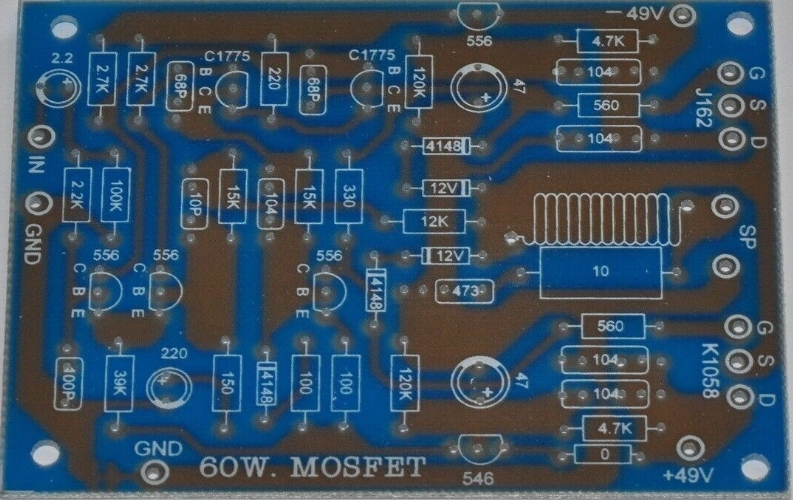In the world of electronics, the printed circuit board (PCB) plays a crucial role in the functionality and reliability of devices. Among the various types of PCBs, the empty amplifier PCB board stands out due to its specific applications in audio amplification and signal processing. This article delves into the intricacies of empty amplifier PCB boards, their importance, and what to consider when ordering them, including delivery dates and business days for shipping.

An empty amplifier PCB board is essentially a blank canvas for electronic enthusiasts and professionals alike. It is a PCB designed specifically for building amplifier circuits, which are essential for boosting audio signals. These boards are devoid of components, giving users the flexibility to customize their amplifier circuits according to their specific requirements.
Customization: One of the primary reasons to opt for an empty amplifier PCB board is the ability to customize the circuit. Whether you are building a high-fidelity audio system or a simple sound amplifier, an empty PCB allows you to select and place components as per your design.
Learning Tool: For electronics students and hobbyists, working with an empty amplifier PCB board is an excellent way to learn about circuit design and assembly. It provides hands-on experience in soldering, component placement, and troubleshooting.
Prototyping: Before mass production, engineers often use empty amplifier PCB boards to prototype their designs. This helps in identifying any design flaws and making necessary adjustments before finalizing the product.
High-Quality Material: The durability and performance of a PCB depend significantly on the material used. High-quality FR4 material is commonly used for amplifier PCBs due to its excellent electrical insulation and mechanical strength.
Copper Thickness: The thickness of the copper layer on the PCB affects its current-carrying capacity. For amplifier circuits, a thicker copper layer ensures better conductivity and heat dissipation.
Layout Design: The layout of an empty amplifier PCB board is crucial for minimizing noise and interference. A well-designed layout ensures optimal signal flow and reduces the chances of signal degradation.
When ordering an empty amplifier PCB board, there are several factors to consider to ensure you receive a product that meets your requirements.
Choosing a reliable supplier is the first step in acquiring a high-quality empty amplifier PCB board. Look for suppliers with positive reviews, a track record of delivering quality products, and good customer service.
Understanding the delivery dates and business days involved in the shipping process is crucial for planning your project timeline. Most suppliers provide an estimated delivery date based on their production schedule and shipping options. Here are some key points to consider:
Production Time: This is the time taken by the supplier to manufacture the empty amplifier PCB board. It can range from a few days to several weeks, depending on the complexity of the design and the supplier's workload.
Shipping Time: Once the PCB is manufactured, it needs to be shipped to your location. Shipping time varies based on the shipping method (standard, express, etc.) and the destination. It is essential to factor in business days, as weekends and holidays can affect the delivery schedule.
Lead Time: The total lead time is the sum of production time and shipping time. Ensure that the lead time fits within your project schedule to avoid delays.
The cost of an empty amplifier PCB board depends on several factors, including the size of the board, the number of layers, and the quantity ordered. Bulk orders often come with discounts, so consider ordering multiple boards if you have ongoing projects.
Ensure that the supplier provides quality assurance measures, such as testing and inspection, to guarantee that the empty amplifier PCB boards are free from defects and meet your specifications.
Once you receive your empty amplifier PCB board, the next step is to assemble your amplifier circuit. Here are some general steps to follow:
Component Selection: Choose components that match your circuit design. This includes resistors, capacitors, transistors, and other necessary parts.
Soldering: Carefully solder the components onto the PCB. Ensure that each connection is secure and free from solder bridges.
Testing: After assembly, test the circuit to ensure it functions as expected. Use a multimeter to check for continuity and proper voltage levels.
Troubleshooting: If the circuit does not work correctly, troubleshoot by checking for incorrect connections, faulty components, or design errors.
An empty amplifier PCB board is a blank circuit board designed for building amplifier circuits. It allows users to customize and assemble their amplifier designs by placing and soldering components onto the board.
The delivery time for an empty amplifier PCB board depends on the supplier's production schedule and shipping method. Typically, it can take from a few days to several weeks. Be sure to check the estimated delivery dates and account for business days when planning your project.
When ordering an empty amplifier PCB board, consider the supplier's reputation, delivery dates, production time, shipping time, cost, and quality assurance measures. Ensure that the lead time fits your project schedule.
Yes, empty amplifier PCB boards are ideal for prototyping. They allow engineers and hobbyists to test their amplifier designs before mass production, helping to identify and correct any design flaws.
High-quality empty amplifier PCB boards are typically made from FR4 material, known for its excellent electrical insulation and mechanical strength. The copper thickness on the board also plays a crucial role in its performance.
To ensure the quality of an empty amplifier PCB board, choose a reputable supplier that provides quality assurance measures such as testing and inspection. This helps guarantee that the boards are free from defects and meet your specifications.
In conclusion, an empty amplifier PCB board is a versatile and essential tool for anyone involved in audio amplification and electronics. By understanding the key features, ordering process, and assembly steps, you can effectively utilize these boards for your projects. Always consider delivery dates and business days when planning your orders to ensure timely completion of your projects.